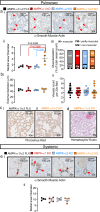AMPK deficiency in smooth muscles causes persistent pulmonary hypertension of the new-born and premature death
- PMID: 36028487
- PMCID: PMC9418192
- DOI: 10.1038/s41467-022-32568-7
AMPK deficiency in smooth muscles causes persistent pulmonary hypertension of the new-born and premature death
Abstract
AMPK has been reported to facilitate hypoxic pulmonary vasoconstriction but, paradoxically, its deficiency precipitates pulmonary hypertension. Here we show that AMPK-α1/α2 deficiency in smooth muscles promotes persistent pulmonary hypertension of the new-born. Accordingly, dual AMPK-α1/α2 deletion in smooth muscles causes premature death of mice after birth, associated with increased muscularisation and remodeling throughout the pulmonary arterial tree, reduced alveolar numbers and alveolar membrane thickening, but with no oedema. Spectral Doppler ultrasound indicates pulmonary hypertension and attenuated hypoxic pulmonary vasoconstriction. Age-dependent right ventricular pressure elevation, dilation and reduced cardiac output was also evident. KV1.5 potassium currents of pulmonary arterial myocytes were markedly smaller under normoxia, which is known to facilitate pulmonary hypertension. Mitochondrial fragmentation and reactive oxygen species accumulation was also evident. Importantly, there was no evidence of systemic vasculopathy or hypertension in these mice. Moreover, hypoxic pulmonary vasoconstriction was attenuated by AMPK-α1 or AMPK-α2 deletion without triggering pulmonary hypertension.
© 2022. The Author(s).
Conflict of interest statement
The authors declare no competing interests.
Figures










Similar articles
-
The LKB1-AMPK-α1 signaling pathway triggers hypoxic pulmonary vasoconstriction downstream of mitochondria.Sci Signal. 2018 Oct 2;11(550):eaau0296. doi: 10.1126/scisignal.aau0296. Sci Signal. 2018. PMID: 30279167
-
Adenosine monophosphate-activated protein kinase is required for pulmonary artery smooth muscle cell survival and the development of hypoxic pulmonary hypertension.Am J Respir Cell Mol Biol. 2013 Oct;49(4):609-18. doi: 10.1165/rcmb.2012-0446OC. Am J Respir Cell Mol Biol. 2013. PMID: 23668615 Free PMC article.
-
AMP-activated protein kinase inhibits Kv 1.5 channel currents of pulmonary arterial myocytes in response to hypoxia and inhibition of mitochondrial oxidative phosphorylation.J Physiol. 2016 Sep 1;594(17):4901-15. doi: 10.1113/JP272032. Epub 2016 Jun 30. J Physiol. 2016. PMID: 27062501 Free PMC article.
-
Modulation of the LKB1-AMPK Signalling Pathway Underpins Hypoxic Pulmonary Vasoconstriction and Pulmonary Hypertension.Adv Exp Med Biol. 2015;860:89-99. doi: 10.1007/978-3-319-18440-1_11. Adv Exp Med Biol. 2015. PMID: 26303471 Review.
-
Smooth muscle acid-sensing ion channel 1: pathophysiological implication in hypoxic pulmonary hypertension.Exp Physiol. 2015 Feb 1;100(2):111-20. doi: 10.1113/expphysiol.2014.081612. Epub 2015 Jan 14. Exp Physiol. 2015. PMID: 25398716 Review.
Cited by
-
Empagliflozin Plays Vasoprotective Role in Spontaneously Hypertensive Rats via Activation of the SIRT1/AMPK Pathway.Cells. 2025 Mar 29;14(7):507. doi: 10.3390/cells14070507. Cells. 2025. PMID: 40214461 Free PMC article.
-
An "inside-out"-guided genetically engineered hydrogel for augmenting aged bone regeneration.Bioact Mater. 2025 May 19;51:318-332. doi: 10.1016/j.bioactmat.2025.05.003. eCollection 2025 Sep. Bioact Mater. 2025. PMID: 40491685 Free PMC article.
-
Genetic adaptations shaping survival, pregnancy, and life at high altitude and sea level.Philos Trans R Soc Lond B Biol Sci. 2025 Aug 21;380(1933):20240170. doi: 10.1098/rstb.2024.0170. Epub 2025 Aug 21. Philos Trans R Soc Lond B Biol Sci. 2025. PMID: 40836810 Free PMC article. Review.
-
The role and mechanism of AMPK in pulmonary hypertension.Ther Adv Respir Dis. 2024 Jan-Dec;18:17534666241271990. doi: 10.1177/17534666241271990. Ther Adv Respir Dis. 2024. PMID: 39136335 Free PMC article. Review.
-
Exosomal miR-663b from "M1" macrophages promotes pulmonary artery vascular smooth muscle cell dysfunction through inhibiting the AMPK/Sirt1 axis.Aging (Albany NY). 2023 May 4;15(9):3549-3571. doi: 10.18632/aging.204690. Epub 2023 May 4. Aging (Albany NY). 2023. PMID: 37142272 Free PMC article.
References
Publication types
MeSH terms
Substances
Grants and funding
LinkOut - more resources
Full Text Sources
Medical
Molecular Biology Databases

